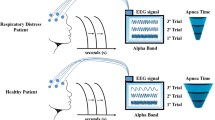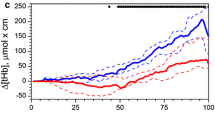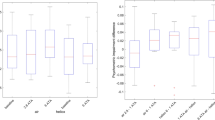Abstract
Voluntary apnea showcases extreme human adaptability in trained individuals like professional free divers. We evaluated the psychological and physiological adaptation and the functional cerebral changes using electroencephalography (EEG) and functional Magnetic Resonance Imaging (fMRI) to 6.5 min of dry static apnea performed by a world champion free diver. Compared to resting state at baseline, breath holding was characterized by increased EEG power and functional connectivity in the alpha band, along with decreased delta band connectivity. fMRI connectivity was increased within the default mode network (DMN) and visual areas but decreased in pre- and postcentral cortices. While these changes occurred in regions overlapping with cerebral signatures of several meditation practices, they also display some unique features that suggest an altered somatosensory integration. As suggested by self-reports, these findings could reflect the ability of elite free divers to create a state of sensory dissociation when performing prolonged apnea.




Similar content being viewed by others
References
Akani A, Karidioula H, Bony K et al (2021) Feasibility of detecting brain areas involved in extreme breath-hold diving. J Neurol Res Ther 3:1–8. https://doi.org/10.14302/issn.2470
Arambula P, Peper E, Kawakami M, Hughes Gibney K (2001) The physiological correlates of Kundalini Yoga meditation: a study of a yoga master. Appl Psychophysiol Biofeedback 26:147–153. https://doi.org/10.1023/a:1011343307783
Bain AR, Ainslie PN, Barak OF et al (2017) Hypercapnia is essential to reduce the cerebral oxidative metabolism during extreme apnea in humans. J Cereb Blood Flow MeTab 37:3231–3242. https://doi.org/10.1177/0271678X16686093
Bain AR, Drvis I, Dujic Z et al (2018) Physiology of static breath holding in elite apneists. Exp Physiol 103:635–651. https://doi.org/10.1113/EP086269
Bharath RD, Panda R, Saini J et al (2017) Dynamic local connectivity uncovers altered brain synchrony during propofol sedation. Sci Rep 7:1–10. https://doi.org/10.1038/s41598-017-08135-2
Bodart O, Fecchio M, Massimini M et al (2018). SC Brain Stimul. https://doi.org/10.1016/j.brs.2018.08.018
Braboszcz C, Delorme A (2011) Lost in thoughts: neural markers of low alertness during mind wandering. Neuroimage 54:3040–3047. https://doi.org/10.1016/j.neuroimage.2010.10.008
Cahn BR, Polich J (2013) Meditation states and traits: EEG, ERP, and neuroimaging studies. Psychol Conscious Theory Res Pract 1:48–96. https://doi.org/10.1037/2326-5523.1.s.48
Cechetto DF (2014) Cortical control of the autonomic nervous system. Exp Physiol 99:326–331. https://doi.org/10.1113/expphysiol.2013.075192
Chen ACN, Feng W, Zhao H et al (2008) EEG default mode network in the human brain: spectral regional field powers. Neuroimage 41:561–574. https://doi.org/10.1016/j.neuroimage.2007.12.064
Chiesa A (2010) Vipassana meditation: systematic review of current evidence. J Altern Complement Med 16:37–46. https://doi.org/10.1089/acm.2009.0362
Craig ADB (2011) Significance of the insula for the evolution of human awareness of feelings from the body. Ann N Y Acad Sci 1225:72–82. https://doi.org/10.1111/j.1749-6632.2011.05990.x
Cunningham SI, Tomasi D, Volkow ND (2017) Structural and functional connectivity of the precuneus and thalamus to the default mode network. Hum Brain Mapp 38:938–956. https://doi.org/10.1002/hbm.23429
Delorme A, Makeig S (2004) EEGLAB: an open source toolbox for analysis of single-trial EEG dynamics including independent component analysis. J Neurosci Methods 134:9–21. https://doi.org/10.1016/j.jneumeth.2003.10.009
Devinsky O (2000) Right cerebral hemisphere dominance for a sense of corporeal and emotional self. Epilepsy Behav 1:60–73. https://doi.org/10.1006/ebeh.2000.0025
Foster GE, Sheel AW (2005) The human diving response, its function, and its control. Scand J Med Sci Sport 15:3–12. https://doi.org/10.1111/j.1600-0838.2005.00440.x
Fransson P, Marrelec G (2008) The precuneus/posterior cingulate cortex plays a pivotal role in the default mode network: evidence from a partial correlation network analysis. Neuroimage 42:1178–1184. https://doi.org/10.1016/j.neuroimage.2008.05.059
Franzmeier N, Caballero MÁA, Taylor ANW et al (2017) Resting-state global functional connectivity as a biomarker of cognitive reserve in mild cognitive impairment. Brain Imaging Behav 11:368–382. https://doi.org/10.1007/s11682-016-9599-1
Gosseries O, Fecchio M, Wolff A et al (2020) Clinical neurophysiology. Clin Neurophysiol 131:586–588. https://doi.org/10.1016/j.clinph.2019.11.011
Greyson B (1983) The near-death experience scale. J Nerv Ment Dis 171:369–375
Hardmeier M, Hatz F, Bousleiman H et al (2014) Reproducibility of functional connectivity and graph measures based on the phase lag index (PLI) and weighted phase lag index (wPLI) derived from high resolution EEG. PLoS One 9:e0108648. https://doi.org/10.1371/journal.pone.0108648
Harmony T (2013) The functional significance of delta oscillations in cognitive processing. Front Integr Neurosci 7:1–10. https://doi.org/10.3389/fnint.2013.00083
Hebert R, Lehmann D, Tan G et al (2005) Enhanced EEG alpha time-domain phase synchrony during transcendental meditation: implications for cortical integration theory. Signal Process 85:2213–2232. https://doi.org/10.1016/j.sigpro.2005.07.009
Heine L, Soddu A, Gómez F et al (2012) Resting state networks and consciousness: alterations of multiple resting state network connectivity in physiological, pharmacological, and pathological consciousness states. Front Psychol 3:1–12. https://doi.org/10.3389/fpsyg.2012.00295
Heusser K, Dzamonja G, Tank J et al (2009) Cardiovascular regulation during apnea in elite divers. Hypertension 53:719–724. https://doi.org/10.1161/HYPERTENSIONAHA.108.127530
Horner RL, Bradley TD (2007) Update in sleep and control of ventilation 2006. Am J Respir Crit Care Med 175:426–431. https://doi.org/10.1164/rccm.200701-043UP
Hou X, Liu P, Gu H et al (2019) Estimation of brain functional connectivity from hypercapnia BOLD MRI data: validation in a lifespan cohort of 170 subjects. Neuroimage 186:455–463. https://doi.org/10.1016/j.neuroimage.2018.11.028
Javorka M, Žila I, Javorka K, Čalkovská A (2002) Do the oscillations of cardiovascular parameters persist during voluntary apnea in humans? Physiol Res 51:227–238
Kawakami Y, Natelson BH, DuBois AR (1967) Cardiovascular effects of face immersion and factors affecting diving reflex in man. J Appl Physiol 23:964–970. https://doi.org/10.1152/jappl.1967.23.6.964
King JR, Sitt JD, Faugeras F et al (2013) Information sharing in the brain indexes consciousness in noncommunicative patients. Curr Biol 23:1914–1919. https://doi.org/10.1016/j.cub.2013.07.075
Lal C, Strange C, Bachman D (2012) Neurocognitive impairment in obstructive sleep apnea. Chest 141:1601–1610. https://doi.org/10.1378/chest.11-2214
Laurino M, Menicucci D, Mastorci F et al (2012) Mind-body relationships in elite apnea divers during breath holding: a study of autonomic responses to acute hypoxemia. Front Neuroeng 5:1–10. https://doi.org/10.3389/fneng.2012.00004
Lee DJ, Kulubya E, Goldin P et al (2018) Review of the neural oscillations underlying meditation. Front Neurosci 12:1–7. https://doi.org/10.3389/fnins.2018.00178
Lehmann D, Faber PL, Tei S et al (2012) Reduced functional connectivity between cortical sources in five meditation traditions detected with lagged coherence using EEG tomography. Neuroimage 60:1574–1586. https://doi.org/10.1016/j.neuroimage.2012.01.042
Lumb AB, Nunn JF (2010) Nunn’s applied respiratory physiology. Chap. 4, Churchill Livingstone, Elsevier, Edinburgh
Martial C, Cassol H, Laureys S, Gosseries O (2020) Near-death experience as a probe to explore (disconnected) consciousness. Trends Cogn Sci 24:173–183. https://doi.org/10.1016/j.tics.2019.12.010
McKay LC, Evans KC, Frackowiak RSJ, Corfield DR (2003) Neural correlates of voluntary breathing in humans. J Appl Physiol 95:1170–1178. https://doi.org/10.1152/japplphysiol.00641.2002
Melnychuk MC, Dockree PM, O’Connell RG et al (2018) Coupling of respiration and attention via the locus coeruleus: effects of meditation and pranayama. Psychophysiology 55:13091. https://doi.org/10.1111/psyp.13091
Metzinger T (2020) Minimal phenomenal experience meditation, tonic alertness, and the phenomenology of “pure” consciousness. Philos Mind Sci 1:1–44
Min BK (2010) A thalamic reticular networking model of consciousness. Theor Biol Med Model 7:1–18. https://doi.org/10.1186/1742-4682-7-10
Mitchell RA, Berger AJ (1975) Neural regulation of respiration. Am Rev Respir Dis 111:206–224. https://doi.org/10.1007/978-3-642-40308-8_2
Morelli MS, Vanello N, Giannoni A et al (2015) Correlational analysis of electroencephalographic and end-tidal carbon dioxide signals during breath-hold exercise. Proc Annu Int Conf IEEE Eng Med Biol Soc EMBS 2015-Nov:6102–6105. https://doi.org/10.1109/EMBC.2015.7319784
Muzik O, Reilly KT, Diwadkar VA (2018) “Brain over body”—a study on the willful regulation of autonomic function during cold exposure. Neuroimage 172:632–641. https://doi.org/10.1016/j.neuroimage.2018.01.067
Ng CW, Noblejas MI, Rodefer JS et al (2007) Double dissociation of attentional resources: prefrontal versus cingulate cortices. J Neurosci 27:12123–12131. https://doi.org/10.1523/JNEUROSCI.2745-07.2007
Nieto FJ, Young TB, Lind BK et al (2000) Association of sleep-disordered breathing, sleep apnea, and hypertension in a large community-based study. Sleep Heart Health Study. JAMA 283(14):1829–1836. https://doi.org/10.1001/jama.283.14.1829
Overgaard K, Friis S, Pedersen RB, Lykkeboe G (2006) Influence of lung volume, glossopharyngeal inhalation and PET O2 and PET CO2 on apnea performance in trained breath-hold divers. Eur J Appl Physiol 97:158–164. https://doi.org/10.1007/s00421-006-0156-2
Panneton WM, Gan Q (2020) The mammalian diving response: inroads to its neural control. Front Neurosci 14:1–27. https://doi.org/10.3389/fnins.2020.00524
Percival DB, Walden AT (1993) Spectral analysis for physical applications: Multitaper and conventional univariatetechniques. Cambridge University Press, Cambridge
Qin P, Northoff G (2011) How is our self related to midline regions and the default-mode network? Neuroimage 57:1221–1233. https://doi.org/10.1016/j.neuroimage.2011.05.028
Ratmanova P, Semenyuk R, Popov D et al (2016) Prolonged dry apnoea: effects on brain activity and physiological functions in breath-hold divers and non-divers. Eur J Appl Physiol 116:1367–1377. https://doi.org/10.1007/s00421-016-3390-2
Reed CL (2002) Tactile perception. In: Ramachandran VS (ed) Encyclopedia of the Human Brain. Academic Press, San Diego, CA, pp 545–556
Ridgway L, McFarland K (2006) Apnea diving: long-term neurocognitive sequelae of repeated hypoxemia. Clin Neuropsychol 20:160–176. https://doi.org/10.1080/13854040590947407
Rolls ET, Huang CC, Lin CP et al (2020) Automated anatomical labelling atlas 3. Neuroimage 206:116189. https://doi.org/10.1016/j.neuroimage.2019.116189
Saalmann YB (2014) Intralaminar and medial thalamic influence on cortical synchrony, information transmission and cognition. Front Syst Neurosci 8:1–8. https://doi.org/10.3389/fnsys.2014.00083
Sadaghiani S, Kleinschmidt A (2016) Brain networks and α-oscillations: structural and functional foundations of cognitive control. Trends Cogn Sci 20:805–817. https://doi.org/10.1016/j.tics.2016.09.004
Schellart NAM, Reits D (1999) Voluntary breath holding affects spontaneous brain activity measured by magnetoencephalography. Undersea Hyperb Med 26:229–234
Schipke JD, Kelm M, Siegmund K et al (2015) “Lung packing” in breath hold-diving: an impressive case of pulmo-cardiac interaction. Respir Med Case Rep 16:120–121. https://doi.org/10.1016/j.rmcr.2015.09.007
Steinberg F, Doppelmayr M (2019) Neurocognitive markers during prolonged breath-holding in freedivers: an event-related EEG study. Front Physiol 10:1–13. https://doi.org/10.3389/fphys.2019.00069
Steinberg F, Pixa NH, Doppelmayr M (2017) Electroencephalographic alpha activity modulations induced by breath-holding in apnoea divers and non-divers. Physiol Behav 179:90–98. https://doi.org/10.1016/j.physbeh.2017.05.028
Steriade M (2006) Grouping of brain rhythms in corticothalamic systems. Neuroscience 137:1087–1106. https://doi.org/10.1016/j.neuroscience.2005.10.029
Tang YY, Hölzel BK, Posner MI (2015) The neuroscience of mindfulness meditation. Nat Rev Neurosci 16:213–225. https://doi.org/10.1038/nrn3916
Teipel S, Bakardjian H, Gonzalez-Escamilla G et al (2018) No association of cortical amyloid load and EEG connectivity in older people with subjective memory complaints. NeuroImage Clin 17:435–443. https://doi.org/10.1016/j.nicl.2017.10.031
Utevsky AV, Smith DV, Huettel SA (2014) Precuneus is a functional core of the default-mode network. J Neurosci 34:932–940. https://doi.org/10.1523/JNEUROSCI.4227-13.2014
Vinck M, Oostenveld R, Van Wingerden M et al (2011) An improved index of phase-synchronization for electrophysiological data in the presence of volume-conduction, noise and sample-size bias. Neuroimage 55:1548–1565. https://doi.org/10.1016/j.neuroimage.2011.01.055
Von Leupoldt A, Vovk A, Bradley MM et al (2010) The impact of emotion on respiratory-related evoked potentials. Psychophysiology 47:579–586. https://doi.org/10.1111/j.1469-8986.2009.00956.x
Ward LM (2013) The thalamus: gateway to the mind. Wiley Interdiscip Rev Cogn Sci 4:609–622. https://doi.org/10.1002/wcs.1256
Wasson D (2013) Pause in breath: potential for altered states of consciousness in traditional Indian performance. In: Embodied Conscious Perform Technol 91–101. https://doi.org/10.1057/9781137320056
Wiech K, Lin CS, Brodersen KH et al (2010) Anterior insula integrates information about salience into perceptual decisions about pain. J Neurosci 30:16324–16331. https://doi.org/10.1523/JNEUROSCI.2087-10.2010
Wolkove N, Kreisman H, Darragh D et al (1984) Effect of transcendental meditation on breathing and respiratory control. J Appl Physiol Respir Environ Exerc Physiol 56:607–612. https://doi.org/10.1152/jappl.1984.56.3.607
Benjamini Y, Hochberg Y (1995) Controlling the false discovery rate: a practical and powerful approach to multiple testing. J R Stat Soc Ser B 57:289–300
Zaccaro A, Penazzi G (2019) Neurophysiological model of altered states of consciousness induced by breathing techniques. Cosm Hist 15:210–224
Zaccaro A, Piarulli A, Laurino M et al (2018) How breath-control can change your life: a systematic review on psycho-physiological correlates of slow breathing. Front Hum Neurosci 12:1–16. https://doi.org/10.3389/fnhum.2018.00353
Acknowledgements
The authors thank the whole staff from the Radiodiagnostic department of the University Hospital of Liège for the help in data acquisition and Benedetta Cecconi for the helpful discussion.
Funding
The study was supported by the University and University Hospital of Liège, the Belgian National Funds for Scientific Research (FRS-FNRS), the European Union’s Horizon 2020 Framework Programme for Research and Innovation under the Specific Grant Agreement No. 945539 (Human Brain Project SGA3), the European Space Agency (ESA) and the Belgian Federal Science Policy Office (BELSPO) in the framework of the PRODEX Programme, the Bial Foundation, the Mind Science Foundation, the fund Generet of the King Baudouin Foundation, the Mind-Care foundation and AstraZeneca Foundation. RP and LS are research fellows, OG is research associate, and SL is research director at FRS-FNRS.
Author information
Authors and Affiliations
Contributions
JA, RP, AP, SL and OG designed research. JA, AP, CM, GN, DL and SL acquired the data. JA, RP and AP analysed the data. JA, RP, CM, AP, LRDS, JMV-V, SL and OG interpreted the results. SL and OG supervised research. JA drafted the manuscript. All authors contributed to result interpretation and the editing of the manuscript.
Corresponding author
Ethics declarations
Conflict of interest
The authors declare no conflict of interest.
Ethical approval
The local ethics committee approved the study.
Consent to participate
The subject provided written informed consent for study participation, in accordance with the declaration of Helsinki (1967) and its later amendments.
Consent for publication
The authors affirm that human research participants provided informed consent for publication of the images in Figure(s) 1, 2, 3, 4. The participant provided informed consent regarding publishing their data and submission of the case report to the journal.
Data availability
The data that support the findings of this study are available from the senior author (Olivia Gosseries (ogosseries@uliege.be) and Steven Laureys (Steven.Laureys@uliege.be) from University of Liege) upon reasonable request.
Code availability
The EEGLAB toolbox code used for EEG pre-processing analyses is freely available online (https://sccn.ucsd.edu/eeglab/download.php). The Fieldtrip toolbox code used for EEG frequency analyses and EEG connectivity analyses is freely available online (https://www.fieldtriptoolbox.org/download/).The CONN toolbox code used for fMRI connectivity analyses is freely available online (http://www.nitrc.org/projects/conn). The “Surf Ice” code used for fMRI connectivity results to display in a glass brain is freely available online (https://www.nitrc.org/projects/surfice/).
Additional information
Publisher's Note
Springer Nature remains neutral with regard to jurisdictional claims in published maps and institutional affiliations.
Supplementary Information
Below is the link to the electronic supplementary material.
Rights and permissions
About this article
Cite this article
Annen, J., Panda, R., Martial, C. et al. Mapping the functional brain state of a world champion freediver in static dry apnea. Brain Struct Funct 226, 2675–2688 (2021). https://doi.org/10.1007/s00429-021-02361-1
Received:
Accepted:
Published:
Issue Date:
DOI: https://doi.org/10.1007/s00429-021-02361-1




